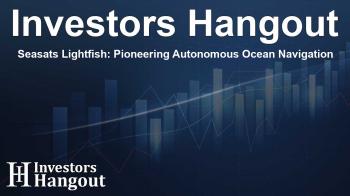Seasats Lightfish: Pioneering Autonomous Ocean Navigation

Seasats Autonomous Vessel Shines on Trans-Pacific Voyage
Seasats, a prominent player in autonomous maritime technology, has achieved a significant milestone as one of its autonomous surface vessels (ASVs) completed a remarkable trans-Pacific journey. The vessel, referred to as Lightfish, successfully reached its destination, marking a new era in low-logistics operations for autonomous maritime systems.
The Mission Overview
The Lightfish vessel embarked on an extensive mission that spanned over 7,500 miles. Commencing from the company’s headquarters, this solar-powered vessel demonstrated its impressive endurance and operational capability. During its journey, it made important stops for demonstrations along the way, showcasing its advanced technology and navigational abilities.
Key Highlights of the Journey
This incredible mission lasted for nearly 150 days, during which the Lightfish showcased exceptional reliability and performance. The tracking of its journey was accessible to the public, allowing enthusiasts and stakeholders to monitor its progress in real-time. The tracking page provided an ocean intelligence feed, illustrating critical metrics about the vessel’s health and nearby maritime activity.
Real-Time Data Sharing
In a move to promote transparency within the industry, Seasats opted to share live tracking data with the public. Max Kramers, one of the co-founders, emphasized that this approach was designed to shift away from traditional presentations that often rely heavily on theoretical data. Instead, Seasats aimed to provide real-time, actionable information to its audience, further establishing its credibility in the sector.
Increasing Demand for Autonomous Systems
The demand for cost-effective, capable unmanned systems is on the rise, aligning with recent initiatives from defense leaders aiming to modernize and enhance drone operations. Mike Flanigan, CEO and co-founder of Seasats, articulated that the capabilities demonstrated during this mission are unmatched by any other USV currently available on the market.
Impact of Lightfish on Maritime Operations
The unique capability of Lightfish allows it to be launched remotely while being monitored from great distances, transforming how maritime operations can be conducted. This technology has already led to multiple deployments across various regions. Earlier this year, Seasats announced that Lightfish had been successfully operated on every inhabited continent, reflecting its global impact.
Broad Applications Across Sectors
Lightfish's adaptability is driving its popularity among various user groups, including defense, research, and commercial sectors. The small size of the ASV facilitates quicker launch capabilities, enabling it to be transported conveniently. Its modular payload adaptability permits it to serve in different capacities, from surveillance missions to environmental monitoring.
Successful Use Cases
Various clients have effectively utilized Lightfish for an array of applications, including intelligence gathering, reconnaissance, and even wildlife monitoring. The positive reception among users highlights the multifaceted nature of this technology, which is proving beneficial for numerous tasks ranging from security operations to ecological studies.
Vision for the Future
Dylan Rodriguez, Seasats' CTO and co-founder, expressed pride in this accomplishment but also emphasized a forward-looking approach. The company envisions regular operations using Lightfish, continuously enhancing its fleet for expansive maritime operations around the globe. The eagerness of customers indicates a burgeoning market for maritime technology, where vessels can independently navigate the oceans.
About Seasats
Seasats specializes in the development of autonomous surface vehicles (ASVs) tailored for extended maritime missions across various sectors, including defense and commercial applications. The Lightfish series showcases exceptional endurance and flexibility, offering organizations a cost-effective solution for enhancing maritime awareness with minimal logistical requirements. Backed by leading industry partners, Seasats remains committed to pioneering advancements in autonomous maritime systems.
Frequently Asked Questions
1. What is the purpose of the Seasats Lightfish vessel?
The Seasats Lightfish is designed for long-duration autonomous maritime operations that serve both defense and commercial sectors.
2. How far did the Lightfish travel?
The Lightfish completed a journey of over 7,500 miles during its trans-Pacific mission.
3. What technology allows Lightfish to operate autonomously?
Lightfish is equipped with advanced navigation systems and solar power technology, enabling autonomous operation over extended distances.
4. Who are the typical users of the Lightfish vessel?
Users include the US Navy, universities, research labs, and various commercial clients.
5. What future plans does Seasats have for Lightfish?
Seasats aims to normalize regular missions with Lightfish, expanding its operational capabilities worldwide.
About The Author
Contact Olivia Taylor privately here. Or send an email with ATTN: Olivia Taylor as the subject to contact@investorshangout.com.
About Investors Hangout
Investors Hangout is a leading online stock forum for financial discussion and learning, offering a wide range of free tools and resources. It draws in traders of all levels, who exchange market knowledge, investigate trading tactics, and keep an eye on industry developments in real time. Featuring financial articles, stock message boards, quotes, charts, company profiles, and live news updates. Through cooperative learning and a wealth of informational resources, it helps users from novices creating their first portfolios to experts honing their techniques. Join Investors Hangout today: https://investorshangout.com/
The content of this article is based on factual, publicly available information and does not represent legal, financial, or investment advice. Investors Hangout does not offer financial advice, and the author is not a licensed financial advisor. Consult a qualified advisor before making any financial or investment decisions based on this article. This article should not be considered advice to purchase, sell, or hold any securities or other investments. If any of the material provided here is inaccurate, please contact us for corrections.

